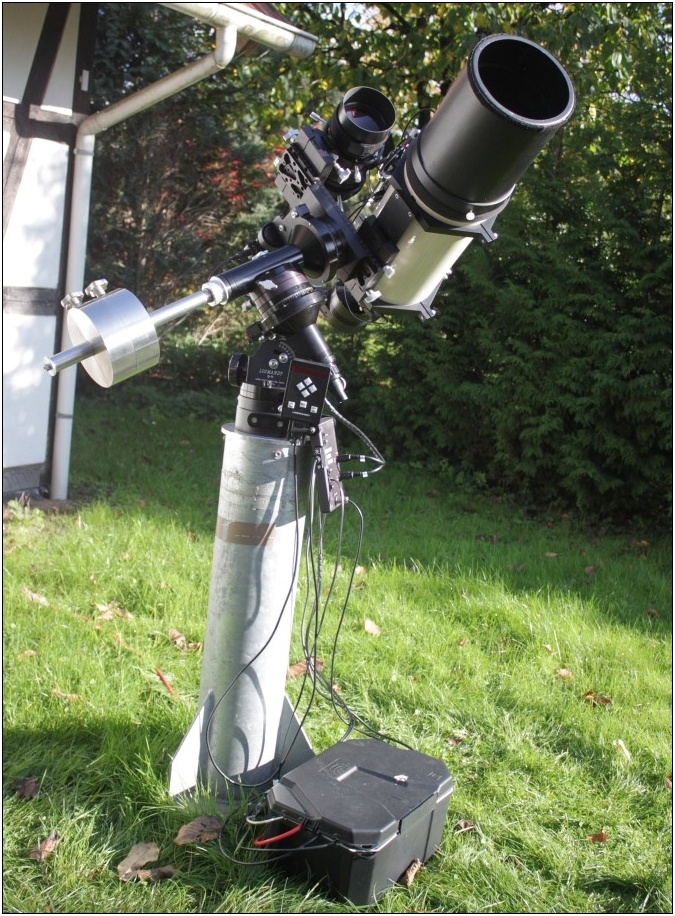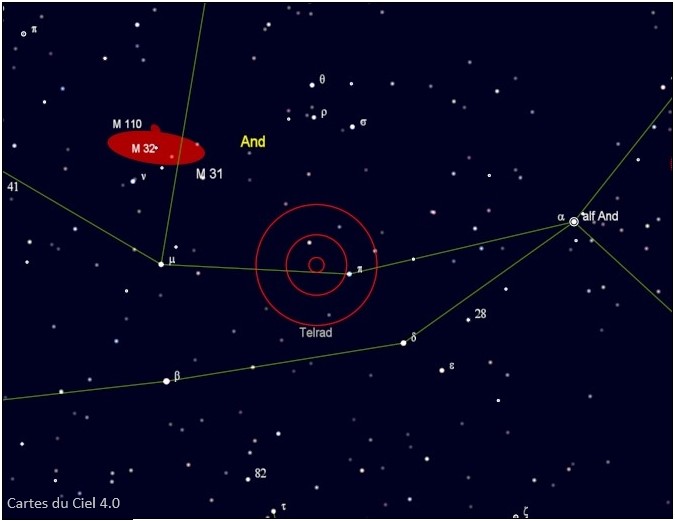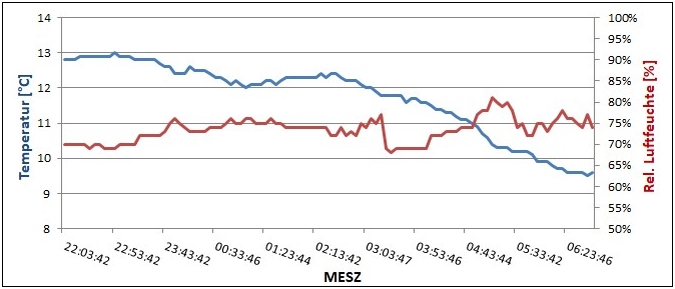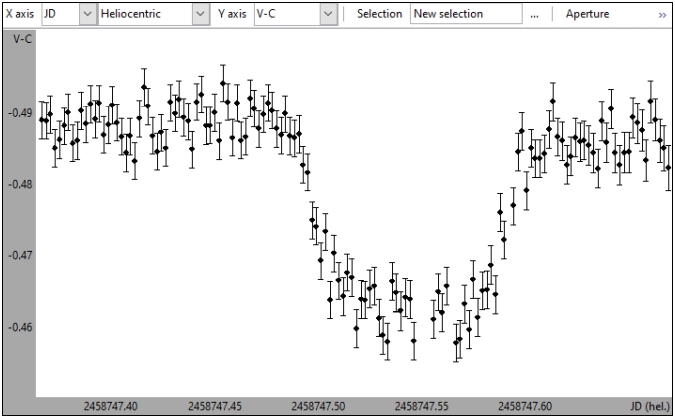Thomas Grunge, 2023 October
The number of discovered planets outside our own solar system, so-called exoplanets, has increased rapidly in recent years. So far (October 2019), at least 4500 planets have been detected in foreign star systems with a great deal of technical effort, using ground-based and space-based instruments.
Can an exoplanet be detected with one's own astro equipment?
Since I had already photometrically measured variable stars and thus gained experience in creating light curves, I decided to use the transit method. Here, the drop in stellar brightness is measured when the exoplanet passes in front of a star from Earth's point of view.

Fig1
The proof should be attempted with the astro equipment already proven in photometry. A 7-inch Maksutov with a focal length of 1.78 m and a SBIG-ST10 CCD camera were used as the recording optics. A Losmandy G11 mount did the tracking. The telescope, mount and camera were controlled and the series of images was created with AstroArt 7.
Observe a transit, but which one and when?
The Internet offers a number of sources for this. With the website of Swarthmore College I have had good experiences. Important inputs here are your own location, minimum star height and the limitation of brightness reduction. You get a list of the transits that will take place in the near future with a lot of information that is necessary for the successful implementation of a transit measurement.
Exoplanet HAT-P-19b
HAT-P-19b lies in the constellation Andromeda, about 1° ENE of Pi Andromeda.

Fig2
HAT-P-19b was discovered in 2010. It orbits a K-type star about 700 light-years away with a visual magnitude of 12.9. The diameter of the exoplanet is slightly larger than that of Jupiter, but it "weighs" just about 1/3 of Jupiter's mass. It only needs 4 days for one orbit, which means a very small distance of only 0.05 astronomical units to its star. Exact values for HAT-P-19b can be found on Exoplanets.org .
Images of HAT-P-19b on 09/20/2019 22:40-06:00 CEST
From September 19-22, 2019, the nights in Dissen near the Teutoburg Forest were clear and windless. On the Swarthmore College website the obeservation parameters of HAT-P-19b were found quickly for 2019.09.20/21. Among the exoplanets, a reduction of the star brightness of 20.1mmag is one of the strongest signals. So the right choice!
Astroart 7's Plate Solving Tool was used to position HAT-P-19b exactly in the center of the image. The V-brightness of the star is 12.9mag and could be well exposed with the optics mentioned above. Test shots were taken in advance to determine exposure time and sharpness. I used the CCD sensitivity to 2/3. All images were taken with an exposure time of 180 seconds with 2×2 binning at -25°C sensor temperature. The sharpness of the recording should be optimally adjusted for the photometry. As a rule, I never focus exactly, but adjust the focus so that the FWHM value of the star is at least 4 pixels. The sharpness is checked during the series of exposures and readjusted if necessary.
The transit itself was from 01:31 to 04:22, so it only took 2:50 hours. It is important to plan enough time before and after the transit in order to properly document the light decay in the light curve. Transit times may also deviate slightly. So I started recording at 10:40 p.m. A total of 139 recordings were made.
The star reached the highest point in the sky at about 75° around the middle of the transit. That was optimal, but meant a meridian flip of the telescope in the middle of the exposure series. It takes a few minutes without recording until everything is running properly again. The meridian flip was performed at around 03:00.
At the end of the recordings, 16 darks, 16 flats and 16 flat darks were made. This is mandatory if you want to prove a brightness drop of a few thousandths of a mag!
Outdoor conditions that night
In order to be able to better interpret the results from the series of images, I document weather conditions and sky quality. For this I use a notebook in which I enter comments about the weather, telescope setup, times such as start, flip, end and object designation, etc. In parallel, a self-made Allsky camera, an AAG Cloudwatcher and a SQM-LE, automatically takes measurements throughout the night.

Fig3
The moon rose on September 20, 2019 at 10:26 p.m., was 61% illuminated, 59° away from HAT-P-19b and could be seen in the sky for the entire series of images. SQM-L values at the zenith were still at 20.19 mag/arcsec^2 at the beginning of the series of recordings, but steadily deteriorated to 17.89 mag/arcsec^2 at the end due to the higher and higher position of the moon.

Fig4
The outside temperature dropped from 12.8°C at the beginning to 9.6°C at the end, so the focus was checked several times. The relative humidity fluctuated between 69% and 81%, so there was no risk of dew formation. The anemometer showed absolutely no wind movement. The sky temperature was almost constant at -17°C, so there were no clouds or veils of cloudiness.

Fig5
The keogram, a sequence of the middle column from the Allsky images, also shows clear skies throughout. The seeing, as far as can be seen from the measurement of the star FWHM values, was better than 4.5 arc seconds.
Overall, the observation conditions were good, apart from the moon.
Evaluation of the recordings
Before the evaluation, it is important to recognize the star with exoplanet in its images. An accurate comparison map can be obtained with the Variable Star Plotter of AAVSO As in my photometric activities with variable stars, the evaluation was carried out with Muniwin 2.x. The program allows the photometry and evaluation of an entire series of photographs. Basically you can run the software with the default parameters. Individual settings can then be changed in order to optimize the result. From my point of view, it is important to create your own camera profile and activate the "matching algorithm for dense fields". It ensures that the stars in the rotated images are correctly assigned after the median flip.
Before creating a light curve, darks, flats and flat darks must be created in Muniwin. After that, the actual recordings can be edited. A correction of the recordings to UTC is an important point so that the data can later be stored in databases. The creation of the light curve then begins with the input of the object and the observation location.
Then the selection of some comparison stars and a check star in the vicinity of the exoplanet is necessary. In advance you should find out about the color index, more precisely about the b-v value, the comparison and check stars. Because only similar b-v values make sense here. Color indices or B and V brightnesses can be found e.g. in Cartes du Ciel in combination with Online-star-catalogs like Simbad The following three comparison stars and one check star were used for the light curve of HAT-P-19b:
The following three comparison stars and one check star were used for the light curve of HAT-P-19b:

Fig6
| RA (2000) | DE (2000) | Bezeichnung | Katalog-Nr. | V | B-V |
| 00 39 08.13 | +34 49 08.04 | var | GSC 02283-00589 | 12.85 | 0.98 |
| 00 39 13.53 | +34 48 04.19 | comp #1 | GSC 02283-01197 | 12.78 | 1.17 |
| 00 38 42.59 | +34 52 13.27 | comp #2 | UCAC4 624-001855 | 13.70 | 0.86 |
| 00 39 05.82 | +34 52 41.35 | comp #3 | UCAC4 624-001871 | 13.99 | 1.00 |
| 00 39 05.91 | +34 51 30.37 | check #1 | UCAC4 624-001872 | 13.90 | 0.76 |
With the help of the check star, the optimal aperture (3.82 pixels) was determined and the light curve was created.

Fig7
The light curve clearly shows the reduction in brightness of about 20 mmag during the exoplanet transit. The small gap in the middle of the transit is the approximately 10-minute pause that occurred due to the median flip. With its own opening, exoplanets can be detected well. It will definitely not be my last exoplanet.
Evaluation of the light curve on the Internet
The Czech Astronomical Society offers the possibility to have your own light curves analyzed and to save the results in a database. Muniwin can output the required data, which is then uploaded. The evaluation of my measurement is here: link .
More information
Wikipedia: https://de.wikipedia.org/wiki/Exoplanet
The HATNet Exoplanet Survey: https://hatnet.org/
Exoplaneten für Amateure: https://www.bav-astro.eu/Rundbriefe/RB2011-4/261.pdf